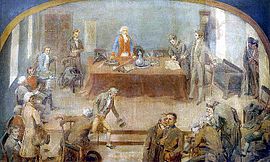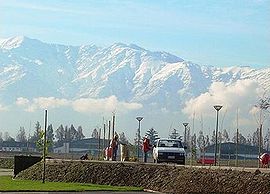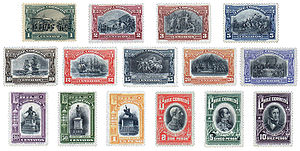- Bicentennial of Chile
-
Commemorative statue of the Bicentennial of Chile, located in Plaza de la Ciudadanía, in front of La Moneda Palace, in Santiago.

The Bicentennial of Chile (Spanish: Bicentenario de Chile) took place on September 18, 2010.[1] Its celebration commemorates the beginning of the Independence process in Chile, with the first Government Junta of Chile on September 18, 1810, and that after eight years, Chile became a free and independent country.[2] Several activities have been prepared for this occasion by the Chilean Government.
The logotype, Logo Bicentenario was created in 2007 by advertising agency Lowe Porta. The stars on it abstractedly represent Latin American countries, and "happiness, celebrations and optimism."[3]
Contents
Background
The Government Junta of 1810 marked the beginning of the political Independence of Chile. It was a government body created by the open council (cabildo) of Santiago de Chile, on September 18, 1810, created in order to organize Chile governmentally and to take actions regarding the government's defense, after Ferdinand VII was taken prisoner by Napoleon Bonaparte in 1808. The Junta was the first autonomous form of government originated in central Chile since its Conquest, and was presided by Governor of Chile Mateo de Toro y Zambrano. It allowed the participation of the creole aristocracy, and it marked the beginning of the Chilean War of Independence. A National Congress was assembled by the Junta, which José Miguel Carrera overturned with a coup d'état.
Bernardo O'Higgins was granted dictatorial powers as Supreme Director of Chile on February 16, 1817, and Chile officially declared its Independence on February 12, 1818.
Plan Bicentenario
The Plan Bicentenario (English: Bicentennial Plan) was started during the government of Ricardo Lagos, and is to be completed on September 18, 2010. A committee, Comisión Bicentenario, was established on October 16, 2002, through Supreme Decree N° 176.
Several plans have been made for the event, amidst them: the construction of major roadworks and infrastructure, such as Plaza de la Ciudadanía, or cultural works, such as La Moneda Palace Cultural Centre (Centro Cultural Palacio de la Moneda), Library of Santiago (Biblioteca de Santiago) and the Matucana 100 Cultural Centre (Centro Cultural Matucana 100).
However, Puente Bicentenario (Bicentennial Bridge), that was going to connect Chiloé with Continental Chile was cancelled, after the estimated cost exceeded the originally budgeted.
Postage stamps
Correos de Chile started in 2008 a public competition to design postage stamps to commemorate the Bicentennial. The contestants were divided into four categories: Basic Education (Enseñanza Básica), Secondary Education (Enseñanza Media), Higher Education (Enseñanza Superior) and Visual Artist (Artista Visual). The winning designs were submitted in 2009, and were created by Andrea Barreda (Basic Education), Javiera Monreal (High School), Joshua Arevalo (Higher Education), and Patricio Díaz (Visual Artist). The Bicentennial stamp series were officially launched on October 15, 2009.[4]
On April 20, 2009, Correos de Chile launched a special issue of 15 stamps that were used for the centenary celebrations of Chile. The stamps dating from 1910 contained the official logo for the Bicentennial, and were sold by CLP$310 (US$0,62). 30,000 copies were print.[5] A stamp with the official logo of the Bicentennial was released too.
Medal
The Mint of Chile (Casa de Moneda de Chile) created a oval-shaped medal, designed by Verónica Astaburuaga. The Bicentennial logo is on the obverse side, and on the reverse a map of Chile, showing the Pacific Ocean, the Andes Mountains and the Andean Cross.[6][7] Two versions of the medal exist, one made of silver, and another of bronze.[7]
Non-governmental initiatives
There have been several non-governmental initiatives which seek to highlight the celebration of the Bicentennial. Some of these initiatives are:
- Edificio Titanium La Portada, inaugurated on May 3, 2010. It is the first building 200 meters high built in Chile by a private company (Inmobiliaria Titanium). It did not suffer any structural damage in the February 27, 2010 earthquake. The Titanium La Portada building is located in Las Condes.
- A replica of Corbeta Esmeralda in Iquique, by Minera Collahuasi. Its cost is estimated in US$3 millions.[8]
- The construction of the tallest skyscraper in Chile, Torre Gran Costanera by Cencosud in Providencia, Santiago.[8]
- "Lágrimas de Luna" Exposition in New York, 2009, inaugurated by Empresas CMPC and El Mercurio. The exposition included several Mapuche jewels.[8]
Television
The Chilean television channels have created several shows to commemorate the Bicentennial. Canal 13 has produced shows such as Flor de País (Flower of Country), Héroes (Heroes), Los 80 (The Eighties), Recomiendo Chile ([I] Recommend Chile), Santiago no es Chile (Santiago is not Chile) and Voy y Vuelvo ([I'll] go and come back [later]).
Televisión Nacional de Chile has broadcasted shows such as Chile Elige (Chile Chooses), Hora 25 (25th Hour), Grandes Chilenos de Nuestra Historia (Greatest Chileans of Our History, based on BBC's 100 Greatest Britons), Epopeya (Epic), and Algo habrán hecho por la historia de Chile (They must have done something for the history of Chile). Chilevisión created the miniseries Postales, that last about a minute and a half. Chilevisión also dramatized guerrilla Manuel Rodríguez Erdoíza's biography on the homonymic TV series.
La Red has exhibited Agenda Bicentenario (Bicentennial Schedule) since 2008, showing important places of Chile during its history. Finally, Megavisión launched the TV series Adiós al Séptimo de Línea (Goodbye to the Seventh Line) in 2010, based on Jorge Inostroza's homonymic book.
Controversies
It has been criticized that the Bicentennial of Chile is celebrated on 2010, because Chile gained its Independence on February 12, 1818, when Bernardo O'Higgins approved the Independence Act of Chile. However, the Centennial of Chile was celebrated on 1910, under the presidency of Pedro Montt (who died on August 16, 1910), Elías Fernández Albano (temporary), Emiliano Figueroa Larraín (temporary) and Ramón Barros Luco.[9] The other countries celebrating its Bicentennial in 2010 also celebrate the beginning of their Independence process through the creation of their First Government Junta, including Venezuela on April 19, Argentina on May 25, Colombia on July 20, Mexico on September 16, Chile on September 18, and Bolivia on May 25, 1809.
Arica and Parinacota, and Tarapacá regions face a historical paradox. These regions will celebrate the Bicentennial, but they have belonged to Chile only for 130 years, because they were formerly part of Peru, which gained its Independence on 1821.[10]
See also
- Bicentennial of Argentina
- Celebration of Mexican political anniversaries in 2010
- United States Bicentennial
References
- ^ "Qué es el Bicentenario" (in Spanish). Chile Bicentenario - Gobierno de Chile. 2010. http://www.chilebicentenario.cl/bicentenario/que-es-el-bicentenario/. Retrieved September 17, 2010.
- ^ "Centenario" (in Spanish). Chile Bicentenario - Gobierno de Chile. http://www.chilebicentenario.cl/bicentenario/centenario/. Retrieved September 17, 2010.
- ^ "Logo Bicentenario Chile 2010" (in Spanish). March 11, 2009. http://www.bold.cl/?p=2768. Retrieved January 2, 2010.
- ^ Correos de Chile (November 2009). "Concurso "Estampillas del Bicentenario"". Revista El Correo. http://www.correos.cl/sala_prensa/revistas/elcorreo/elcorreo110.pdf. Retrieved January 31, 2010.
- ^ Correos de Chile (August 2009). "Reemisión de los sellos del Centenario". Revista El Correo. http://www.correos.cl/sala_prensa/revistas/elcorreo/elcorreo109.pdf. Retrieved January 31, 2010.
- ^ "Medallas". Casa de Moneda de Chile. http://www.casademoneda.cl//wp-content/uploads/2010/04/medallas.pdf. Retrieved April 17, 2010.
- ^ a b "Medalla del Bicentenario". Bicentenario de Chile. http://www.chilebicentenario.cl/frmMedallaBicentenario.aspx?idarticulo=697. Retrieved April 17, 2010.[dead link]
- ^ a b c "Las ideas privadas para el Bicentenario" (in Spanish). El Mercurio. http://diario.elmercurio.com/detalle/index.asp?id=BC959F8D-1166-45F4-87D4-8082FBA272AC.htm?id={BC959F8D-1166-45F4-87D4-8082FBA272AC}. Retrieved September 17, 2010.
- ^ "Un Bicentenario Equívoco" (in Spanish). Dilemas. http://www.dilemas.cl/index.php?option=com_content&view=article&id=433:un-bicentenario-equivoco-&catid=19:destaque. Retrieved January 2, 2010.
- ^ "Bicentenario Arica en 1810: La infancia peruana de la última hija chilena" (in Spanish). La Estrella de Arica. August 29, 2010. http://www.estrellaarica.cl/prontus4_nots/site/artic/20100829/pags/20100829121512.html. Retrieved September 16, 2010.
External links
- Chile Bicentenario (Spanish)
- Centro de Estudios Bicentenario (Spanish)
- Biblioteca Virtual del Bicentenario (Spanish)
- Bicentenario Ciudadano y Popular Chile 2010 (Spanish)
Categories:- 2010 in Chile
- Chilean culture
- History of Chile
- Chilean War of Independence
Wikimedia Foundation. 2010.




